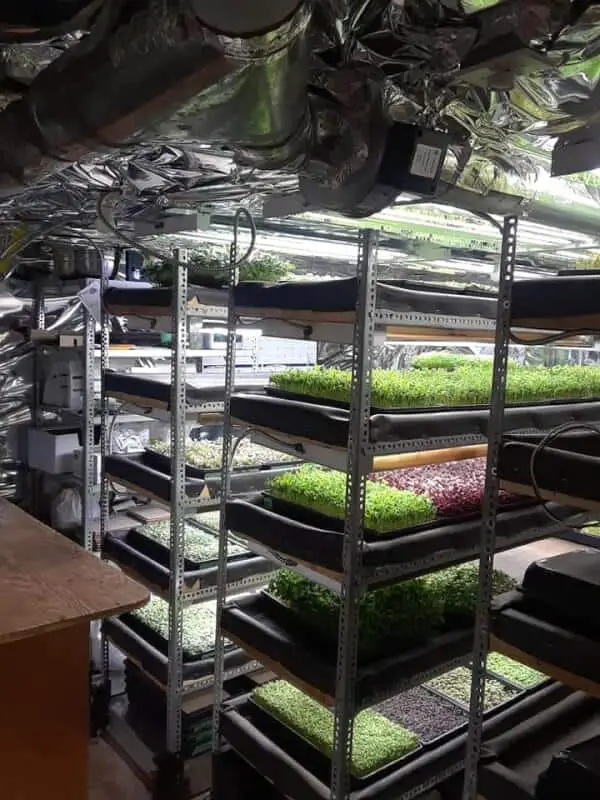Having an indoor garden is a dream for some people. Deciding if your indoor space could accommodate the type and quantity of fruits and veggies you want is the first step in making it a reality.
How many plants can grow in a 10×10 room? Over 1,700 small plants could grow in a room this size, anywhere from 190 to 430 medium-sized plants: 24 to 96 plants for larger or bushier plants. Knowing plant sizes is essential for using an indoor space for your garden. Planting them too close together will cause poor growth and health while planting them too far apart will waste what space you do have.
Are you saying to yourself, “Seriously? More than 1,600 plants in only a 100 square foot room?” You’ll think differently once you see the results of our research. Check out the information below to learn more about seed spacing, size, and planting by square foot instead of rows.
Determining the Spacing of Your Plants
Being able to determine the amount of room you would need between each of your plants is a must when trying to figure out how many plants you could house in a 10×10 room.
But with the help of this guide, you’ll find it as easy as pie, requiring only that you take a look at the back of your seed packets and make a grid for your 100 square-foot-garden.
On the back of your seed placket, you will typically find information on how many days it will take to germinate, depth to sow, growing height, amount of sunlight the plant needs, and seed spacing.
Too Close Together
The seed spacing is so important because if you are a super ambitious person, like me, you are going to want a garden with an abundance of food and a wide variety to choose from. Planting your seeds too close together, though, could cause problems for the plants, like:
- Not get enough oxygen
- Not enough space to flourish
- Easy spread of disease from being right on top of each other
Too Far Apart?
On the other hand, if you only like a few certain types of fruits and vegetables and you only need the garden for yourself, then you may not try to be so bold when planting your garden. But you might be undermining its potential. There is always something more you can grow if you have the space!
You should also understand that there are some plants that require other plants to be near them to pollinate, which encourages fertilization of those plants. Some plants are just needy and need friends nearby.
Read and Heed Your Seed Packets!
So, pay close attention to the information on the back of the seed packet, where you will find exactly how much space your plants need between them even as they start sprouting. It is important, as well, to know whether you are going to plant your seeds by row or by square feet. Rows are useful because you have a walkway between your plants and extremely easy access to them, but you really need an outdoor area for this method.
If you do not have an outdoor space for rows, then it’s a great idea to read up on square foot gardening. This article on bobvila.com even provides sample charts, ideas about incorporating vertical gardening in your space, and more!
Which Plants Are Considered Small, Medium and Large?
The first question I had during my research, besides the whole “how many plants can fit into a 10×10 room,” was which plants are considered small, medium, and large?
Obviously, I could look at some fruits and vegetables in the supermarket and get an idea of which ones were which, assuming a big fruit or vegetable needs a pretty big plant. This observation, however, does not consider the amount of surface area taken up the plant’s growth.
Small Plants can include:
1. Scallion plants– 2-3 inches wide
2. Radish plants- 6-9 inches wide
3. Beet plants- can grow up to 12 inches wide
Medium Plants can include:
1. Tomato plants- can grow up to 2 feet wide
2. Cucumber plants (not on a trellis)- can grow 2 to 3 feet wide
3. Strawberry plants- grow up to 3 feet wide
Large Plants can include:
1. Summer Squash plants– grow anywhere from 3 to 10 feet wide
2. Pumpkin plants- grow anywhere from 3 to 15 feet wide
3. Watermelon plants- grow from 5 to 20 feet wide
These examples illustrate why seed spacing is so important when trying to understand how many plants can fit in a 10×10 room.
Why Would You Consider Having An Indoor Garden?
If you are wondering why you would have an indoor garden, besides not having a yard for one outside, then here are a few benefits.
- Longer growing season. You can have this indoor garden year-round with any type of produce you want if you have adequate lighting!
- Fewer bugs! The chances of having a terrible pest problem are incredibly slim indoors.
- Fresh air – indoors. Ever heard of photosynthesis? You can have your very own pure oxygen producing system right in your own home!
How Did Square Foot Gardening Become So Popular?
A man named Mel Bartholomew invented square foot gardening in 1976. According to this article, he joined a community after retiring as a Civil Engineer and efficiency expert and came to the realization that gardening by rows took way too long and exhausting work. That was when he came up with square foot gardening and wrote a book about it.
After publishing in 1981, people came to realize that row gardening was, in fact, extremely tiring, more tedious, and less efficient than gardening could be. Besides how beautiful those raised beds are, square foot gardening became popular for quite a few reasons.
Source: https://www.bobvila.com/slideshow/pro-tips-square-foot-gardening-44696#planting-seeds
What is Square Foot Gardening?
Square foot spacing is the best route for an indoor garden. Planting your garden by square feet is basically just having raised beds, however big you want them, and measuring each square foot in your bed.
- Plan space to walk! Since your measurements will all be done for a 10×10 room, you must be sure to account for space that will be taken up for your walking paths between each produce box. This will help you get a better picture of how many plants you will be able to fit in your room.
- Make sure you can reach your plants. It is recommended not to make your beds so big that you cannot easily reach all your produce. This will make it easier for you to access your plants and they will be organized, with each plant type in their own box.
Having the garden beds is also a huge plus on the “looks” part because they look quite decorative!
An Example of an Indoor, Square Foot Gardening Plan
Check out the table below that I made based on my research and from the information I found on the Farmer’s Almanac website. To make the most out of the limited space you have, here is an example of how your layout could be. This garden plan could fill 50 square feet of your room with produce! Check out the link to find out which plants and how many you could put in your boxes.
- Each block represents 1 square foot, which is 12 inches by 12 inches.
- Yellow blocks are garden beds.
- White blocks are walkways.

A note about bed size: It is recommended not to make your beds so big that you cannot easily reach all your produce. Most garden beds will be 4×8 or 3×6. This will make it easier for you to access your plants and they will be organized, with each plant type in their own box.
Have you figured out how could possibly plant over 1,600 small vegetables in this little space yet? According to this site, you could plant 36 scallion seeds in each square foot of your garden. If you multiply how many square feet you have, which is 50, by how many seeds you can plant in each square, which is 36 for scallions, then you get an unbelievable number of 1,800!
Maybe That Space Isn’t So Small, After All!
As you can see, you can really maximize the amount of space available to you in a 10×10 room. If you’re mindful of how you use the space and ensure you can reach all of your plants to take good care of them, you’ll be harvesting plenty throughout the growing season!



Subscribe To Our Newsletter
Join our mailing list to receive news and updates. Don't worry. We will not smap you ;)
You have Successfully Subscribed!